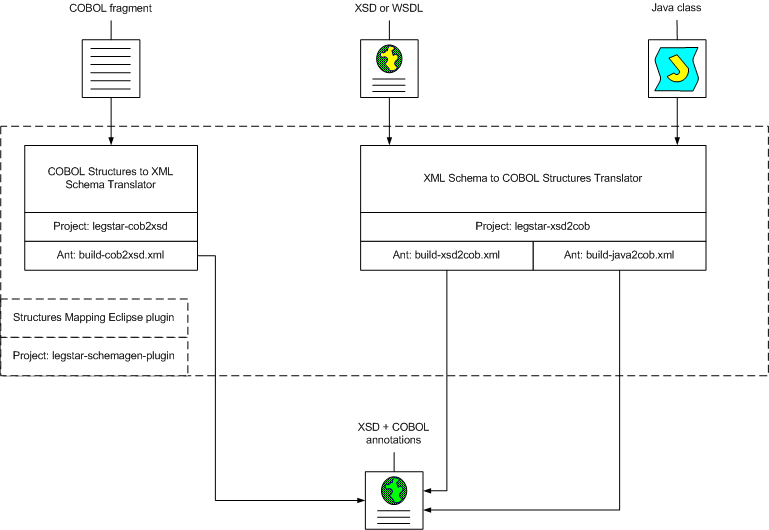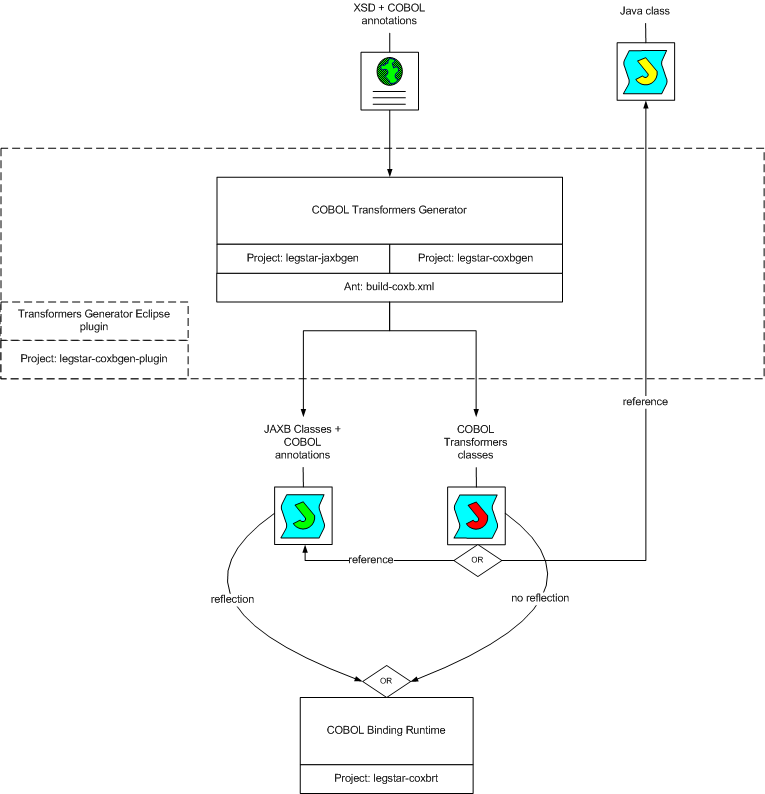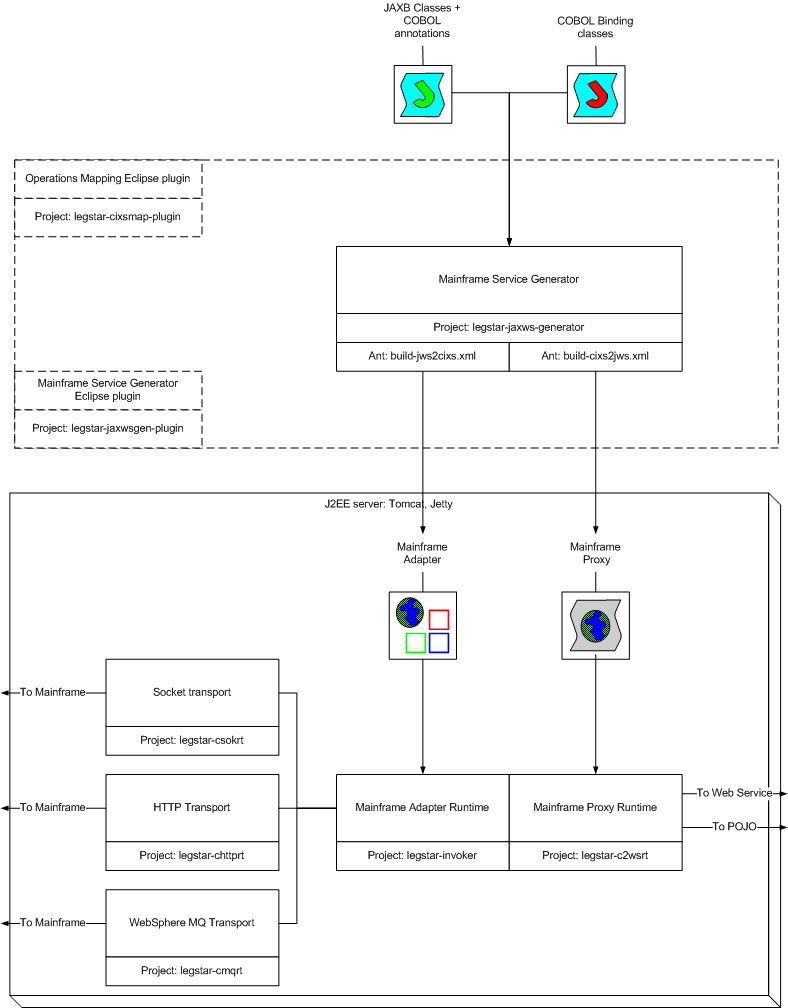

Because COBOL is very often the legacy applications development language, LegStar focuses primarily on this language. For PL/I users, we offer a PL/I to COBOL Structures translator.
Since most open-world languages, such as Java, have already been mapped to XML Schema, the approach we have taken in LegStar is to translate COBOL to XML Schema and then let existing tools, such as, JAXB do the final mapping to the target language.
LegStar has introduced a COBOL binding language to describe how COBOL data items should map to XML Schema elements. That binding language is itself an extension to XML Schema (Annotations).
LegStar provides design time tools to help with data structure translation. Tools are available as ant tasks or Eclipse plugins. The following diagram shows the ant file names and Eclipse plugin name as well as the LegStar projects where you can find the corresponding code:

The translation process can start from COBOL code fragments, XML Schema, Web Service WSDL or Java classes. For more details see COBOL Structures to XML Schema Translator, and XML Schema to COBOL Structures Translator.
To support runtime transformation from mainframe data to Java and vice-versa, a design time tool called the COBOL Transformers Generator produces Transformer Java classes. The tool starts from a COBOL-annotated XML Schema such as the one produced by the Structure Mapping tools.
This feature is built on top of the standard JAXB framework which provides Java to XML binding. As a result of this combination, LegStar can convert mainframe data streams to/from Java objects, XML or JSON.
Using the generated marshaling/unmarshaling Java classes, the COBOL Binding Runtime handles:
Note that transformations do not run on the mainframe itself therefore reducing the mainframe footprint of the solution.
The following diagram shows the ant file name, Eclipse plugin and projects for the COBOL transformers Generator and the Runtime:

Two sets of Java classes are produced by the COBOL Transformers Generator. The first is actually a set of JAXB classes with additional COBOL annotations and the second is used to improve runtime conversion performances.
As the diagram shows, the COBOL Binding Runtime can use either the JAXB classes via reflection or the Transformers classes. The second option is faster since it avoids the expensive reflection process.
The Transformers have either a reference to the JAXB classes or to the source Java classes. In the case where Java classes were used for Structure Mapping, the Transformers directly marshal/unmarshal to and from these classes. Otherwise, when mapping used COBOL fragments or XSD/WSDL, the JAXB classes are used as value objects by the COBOL Transformers.
The transformer capabilities can be used independently from the service-enablement capabilities described next.
LegStar provides Mainframe Service Generators which allows you to map mainframe programs to service operations in a bi-directional fashion. An operation is either a Web Service operation or a pure java object (POJO) method.
There are multiple implementations of this concept, namely for:
For LegStar, a Mainframe Adapter Service is an endpoint that remotely executes a mainframe program. Mainframe programs are thus exposed as Web Services or ESB services.
A LegStar Mainframe Proxy Service acts on behalf of mainframe programs to invoke remote Web Services, POJOs or ESB services.
More precisely, for a Mainframe Adapter Service, invoking the operation executes the mainframe program. For a Mainframe Proxy Service, the Mainframe program calls the proxy to invoke a target Web Service operation or POJO method. Operations are expected to receive a complex type as input and produce a complex type as output.
The activities involved in generating Mainframe Adapter and Proxy Services are symmetrical and they both start from Transformers for input and output such as the one produced by the COBOL Transformers Generator tool.
The following diagram shows the ant file names, Eclipse plugins and projects for the Mainframe Service Generator and the various runtime modules for the JAX-WS target:

The Operation Mapping Eclipse plugin helps with tying operations, mainframe programs and their corresponding input and outputs. The same data can be passed as parameters to the ant scripts.
Once operations are mapped, the generation of a Mainframe Adapter or Proxy can take place. LegStar generates all the artifacts that are needed to create and deploy Mainframe Adapters and Proxies in a J2EE container such as Tomcat or Jetty.
Mainframe Adapters are JAX-WS endpoints while Mainframe Proxies are JAX-WS clients when they need to invoke a Web Service. Both use the COBOL Binding Runtime to marshal/unmarshal the mainframe data payloads.
The Mainframe Adapter Runtime provides the runtime mechanism to invoke a mainframe program. The Adapter Runtime uses a binary protocol that optimizes the payload size. This significantly reduces resource consumption on the mainframe.
The Adapter Runtime legacy environment target is primarily IBM CICS. Nothing prevents the architecture from being extended to other legacy environments in the future.
LegStar fully supports the CICS channel/container mechanism in addition to the standard commarea. LegStar supports multiple input containers and multiple output containers.
In term of transport protocols to CICS, LegStar offers:
Proxies are bundled as Servlets. Once deployed, these Proxy servlets listen for requests from the mainframe and access the target Web Service, or POJO, on behalf of the mainframe client program.
Mainframe programs invoke the Proxy over HTTP. The Mainframe Service Generator produces sample COBOL code for IBM CICS to show how to perform such a call.
The Mainframe Proxy Runtime provides the servlet-based architecture needed to call the target Web Service( using JAX-WS client API) or target POJO.